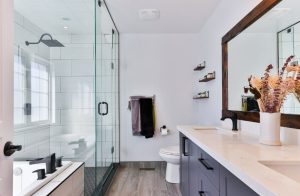In the past the majority of a bathroom would be tiling. You could find it up entire walls, all the way to the ceiling. It could even be on the floor. However, there are many more options today. Some people choose decorative wall and ceiling panels. Others will choose plaster. We want to look at the latter specifically. Then, if you need services from the top plasterers in Sheffield, you can choose us.
Can you use it?
 A lot of people question whether you can actually use plaster in a bathroom. The fact there is high moisture and humidity suggests it would be a bad idea. While that is true with some types, including gypsum, there are others you can use with fewer concerns. You need to select the right material, ensuring you consider how wet the surface will be.
A lot of people question whether you can actually use plaster in a bathroom. The fact there is high moisture and humidity suggests it would be a bad idea. While that is true with some types, including gypsum, there are others you can use with fewer concerns. You need to select the right material, ensuring you consider how wet the surface will be.
It is also a very good idea to think about moisture protection. You can apply a final coat on top of the plaster that prevents water impregnation. You need this for any type of plaster that is susceptible to ingress, including gypsum and cement. While lime and clay plasters can be less vulnerable, it is a good idea to give them a coating too.
What to think about?
If you want the best results, there are a number of things to consider. Most importantly, it is usually better to ask an expert. You can speak to us if you want advice from plasterers in Sheffield.
A crucial factor is how wet the location will be. If it is the area around a bath or a shower there can be a lot of moisture. It can also remain on the walls for a long time too. In these situations plaster may not be the best option. If you do choose it, you must ensure it can withstand the level of moisture.
One massive positive for plaster is it can be anti mould. There are types like lime that are breathable. As a result, they don’t hold moisture and are less likely to become mouldy.
A crucial thing to look at is layering. It is best to plaster a bathroom by doing several layers because it will create more durable surfaces.
You need to think about cold joints too. This occurs where areas with different levels of wetness meet. It can be an issue in corners or where you have overlaps. The best way to tackle it is to do layers quickly.
Finally, you should be careful with outlets. Generally bathrooms don’t need too many of them. It could be just one or two for the light and shower. However, each of them will interrupt the consistency of the plastering. The plasterer must take care working around them.
Do you want help from expert plasterers in Sheffield?
G Lee Plastering is a team you can rely on for any part of a property. We can plaster living rooms, hallways, and more. We also have experience with areas that have higher moisture and humidity, including bathrooms and kitchens. We’ll deliver the best results for every space. Plus, you can ask us for advice.
So, if you want to work with reliable plasterers in Sheffield, contact us. We can provide quotes for any jobs too.